Learn how to make pasta at home! This 4-ingredient homemade pasta recipe is easy to make, and it yields chewy, delicious noodles every time.
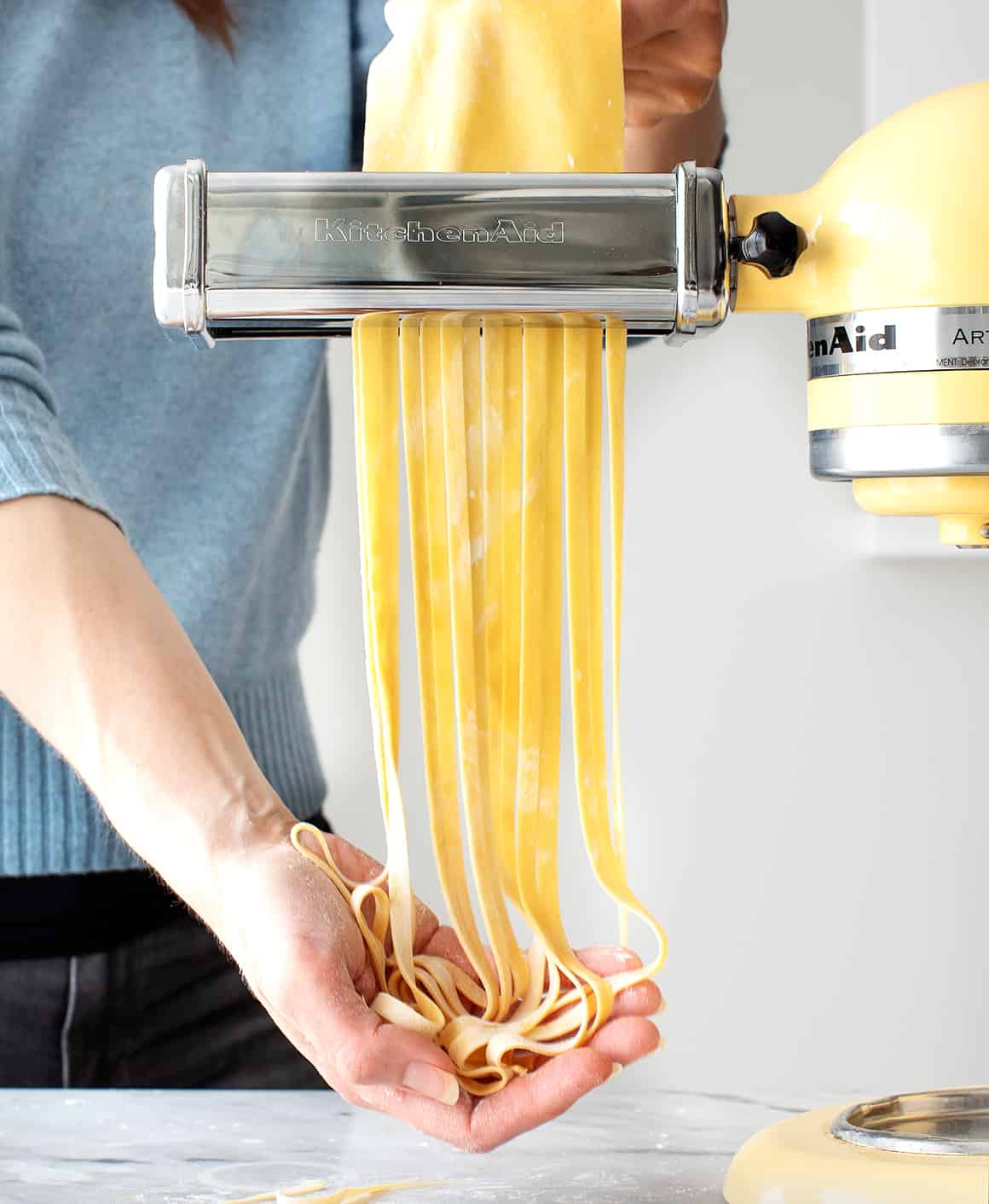
This homemade pasta recipe is our new favorite cooking project! Lately, Jack and I have been spending even more time than usual in the kitchen, experimenting with bread, baked goods, and even okonomiyaki. But we keep coming back to homemade pasta. It’s super fun to make together, and it only requires a handful of basic ingredients. Of course, the fact that it’s absolutely delicious doesn’t hurt either. 🙂
My homemade pasta recipe refers to the pasta maker attachment for the KitchenAid Stand Mixer, which is how we roll out our fresh pasta at home. If you don’t have a KitchenAid, don’t worry! You could also roll out this pasta dough according to the instructions on a regular pasta maker. However you make it, I hope you try this recipe. It’s an easy, fun way to spend an hour in the kitchen with someone you love, and at the end, you get to eat a big plate of chewy noodles with a perfect al dente bite.

Homemade Pasta Recipe Ingredients
You only need 4 ingredients to make delicious fresh pasta at home, and there’s a good chance you have all of them on hand already:
- All-purpose flour – In the past, I thought you needed 00 flour or semolina flour to make great fresh pasta, but this homemade pasta recipe proved me wrong. In it, regular all-purpose flour yields chewy, bouncy noodles every time.
- Eggs – The key ingredient for adding richness and moisture to the dough!
- Olive oil – Along with the eggs, a splash of olive oil moistens the dough and helps it come together.
- Salt – Add it to the dough and the pasta water for the best flavor.
Find the complete recipe with measurements below.

How to Make Pasta
Ready to learn how to make pasta? Check out this step-by-step guide first, and then find the full recipe at the bottom of this post!
First, make a nest with the flour on a clean work surface. Add the remaining ingredients to the center and use a fork to gently break up the eggs. Try to keep the flour walls intact as best as you can!
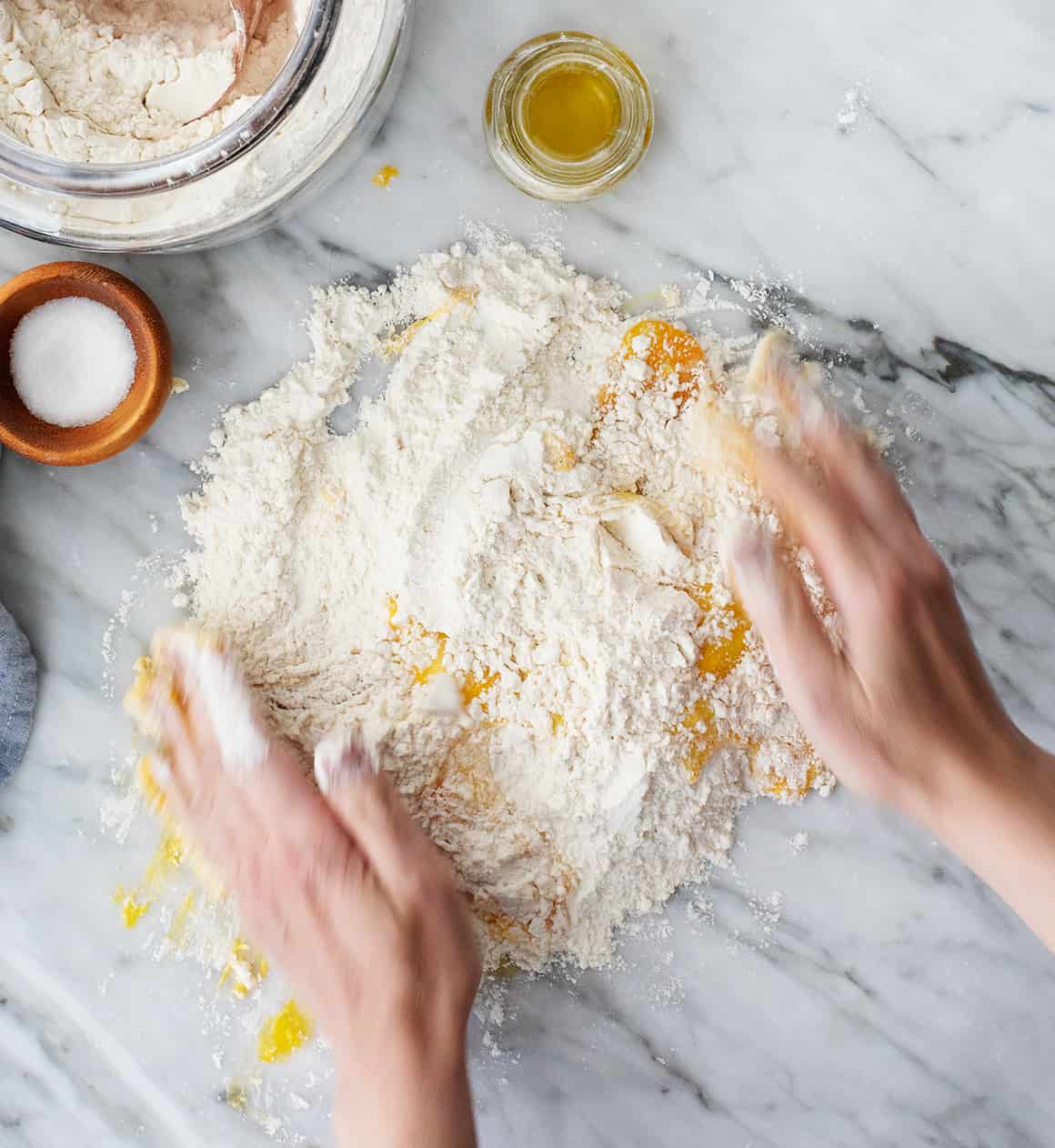
Next, use your hands to gently mix in the flour. Continue working the dough to bring it together into a shaggy ball.
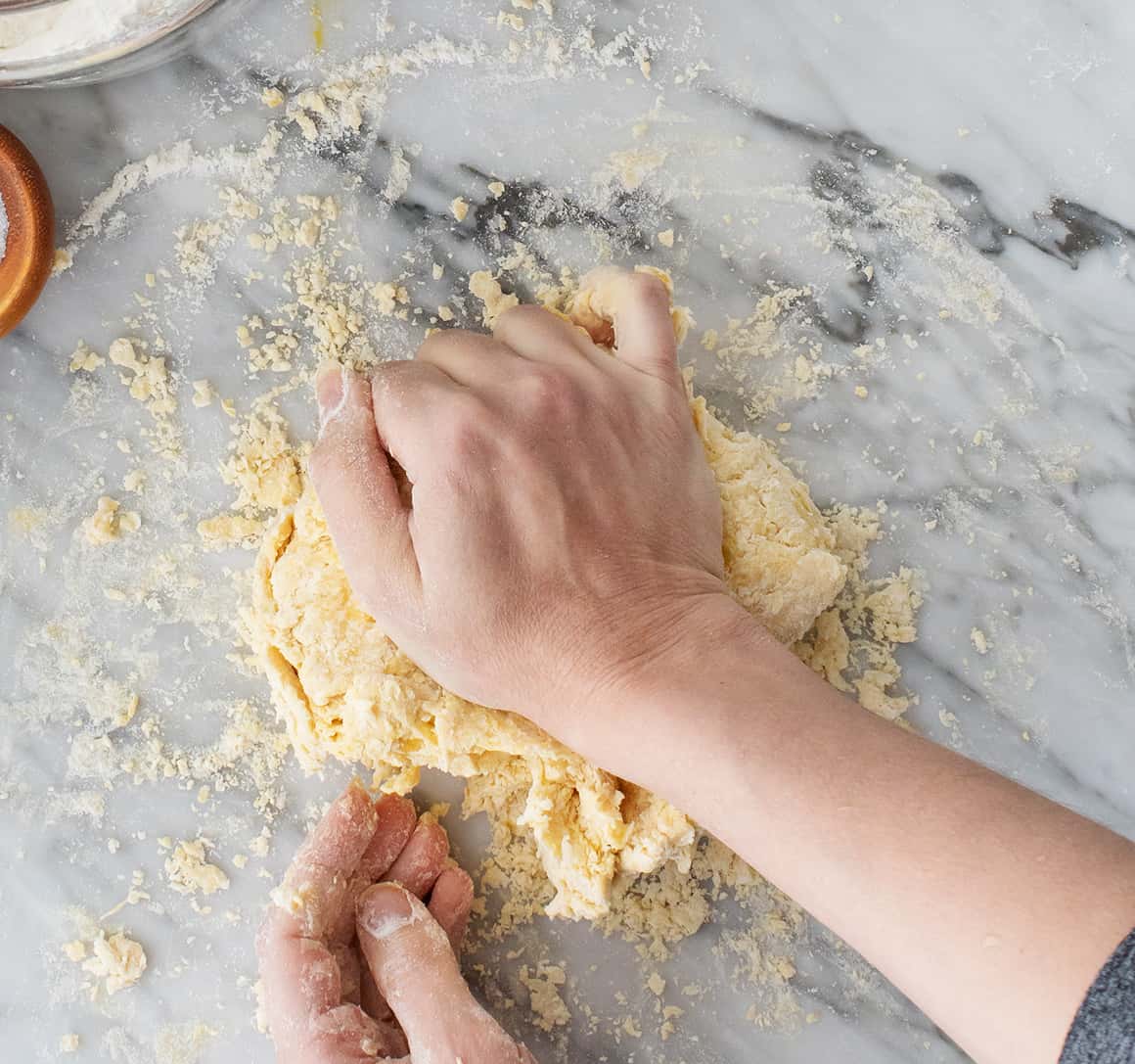
Then, knead! At the beginning, the dough should feel pretty dry, but stick with it! It might not feel like it’s going to come together, but after 8-10 minutes of kneading, it should become cohesive and smooth:

If the dough still seems too dry, sprinkle your fingers with water and continue kneading to incorporate it into the dough. If the dough becomes too sticky, dust more flour onto your work surface.
When the dough comes together, shape it into a ball and wrap it in plastic wrap. Let the dough rest at room temperature for 30 minutes.
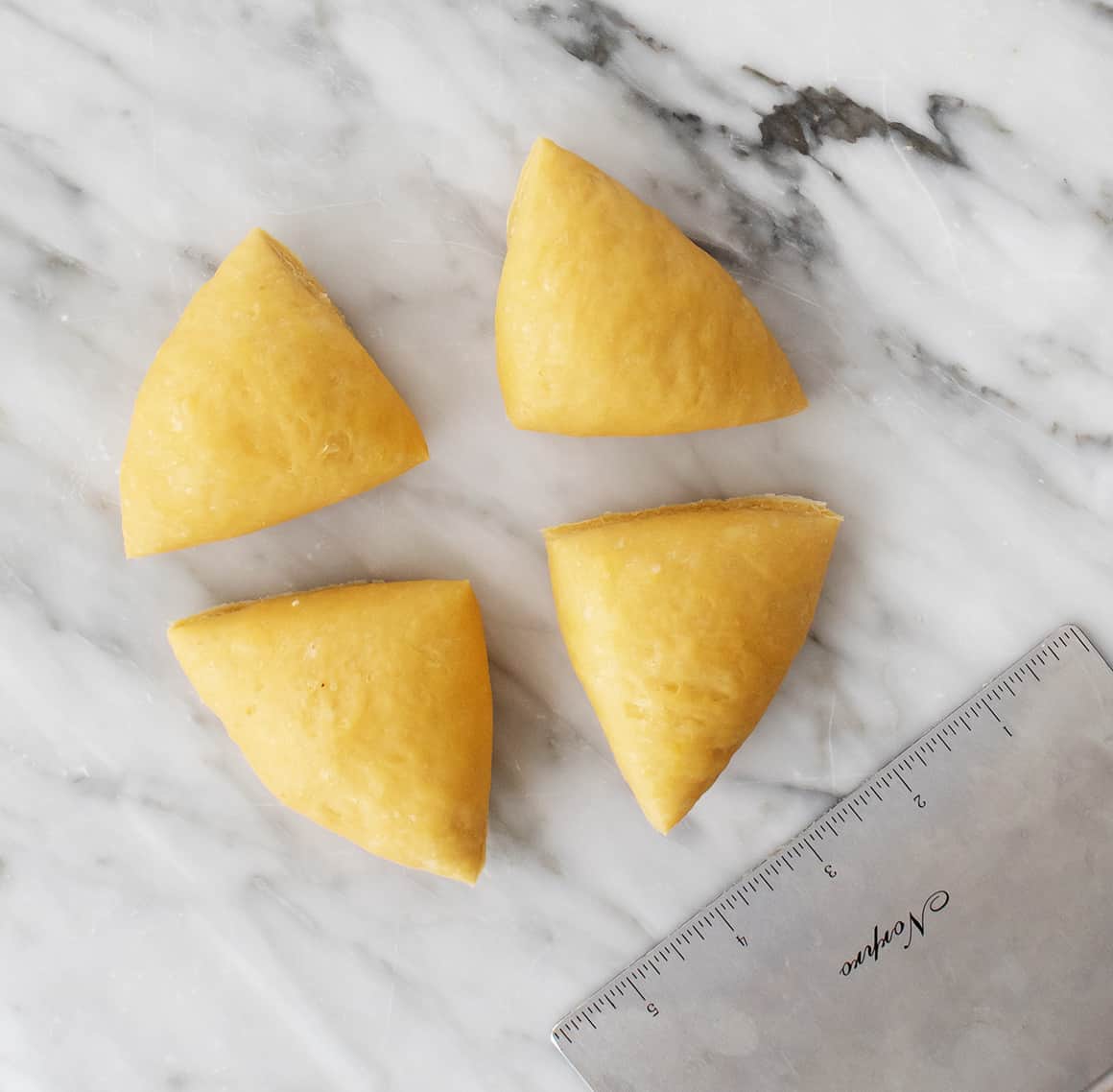
After the dough rests, slice it into 4 pieces.
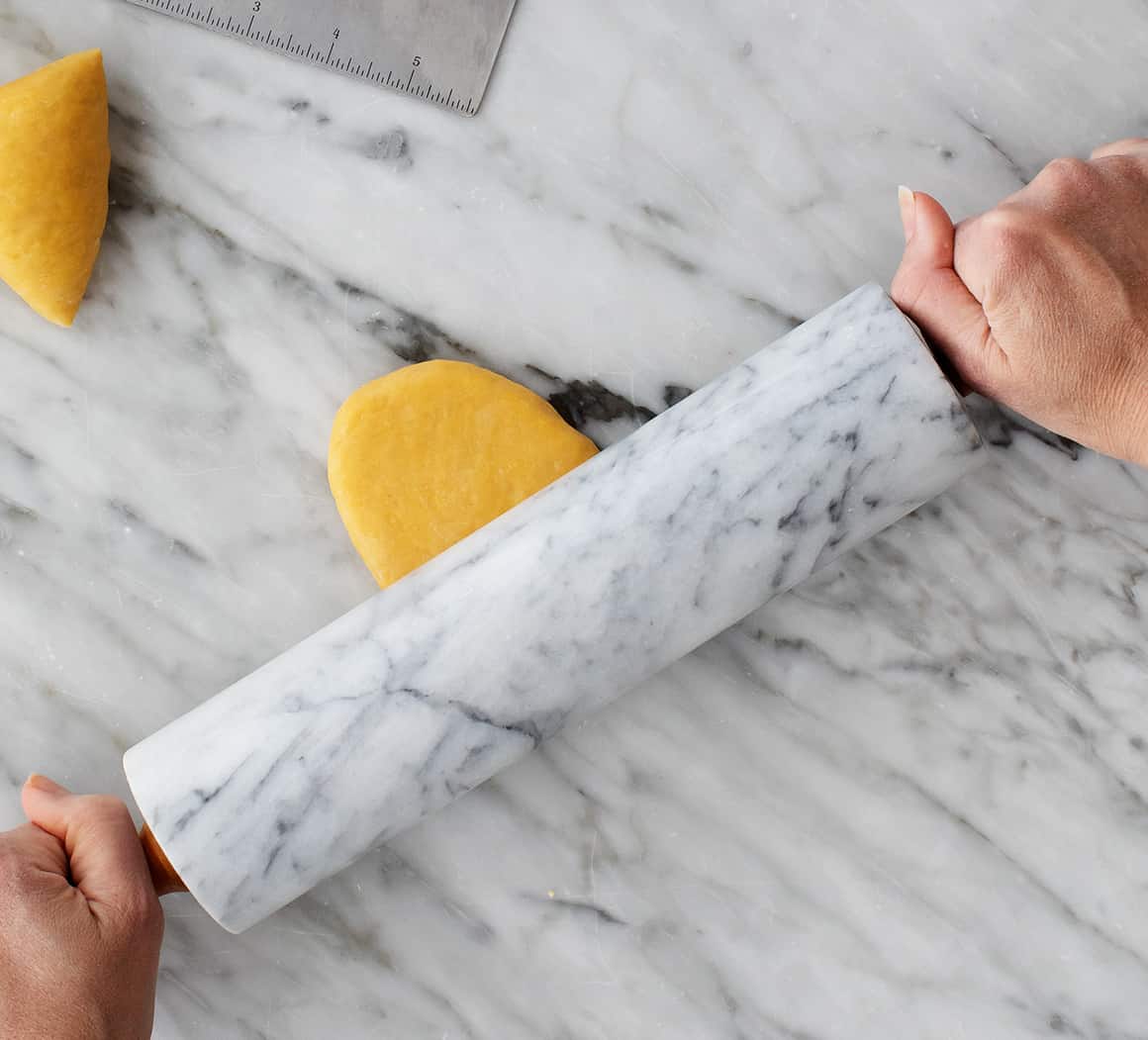
Use a rolling pin or your hands to gently flatten one into an oval disk.

Then, run it through the widest setting of your pasta maker (level 1 on the KitchenAid attachment). I run the dough through the pasta maker 3 times on this setting before proceeding to the next step. If you don’t have the KitchenAid attachment, roll out the dough according to your pasta maker’s instructions.

Next, fold the dough… if you want to. This step is somewhat optional, but it will make your final pasta sheet more rectangular, which will yield more long strands of pasta. Plus, it’s super simple! Just lay the dough flat and fold both short ends in to meet in the center.

Then, fold it in half lengthwise to form a rectangle.

Once you’ve folded the dough, roll it out to your desired thickness. On my KitchenAid attachment, I run it through the pasta roller three times on level 2, three times on level 3, and one time each on levels 4, 5, and 6.
Repeat these steps with the remaining dough pieces. Each time you finish with a piece of dough, lay one half of it on a lightly floured baking sheet. Sprinkle the dough with flour, and fold the other half on top. Sprinkle the top with flour, too!
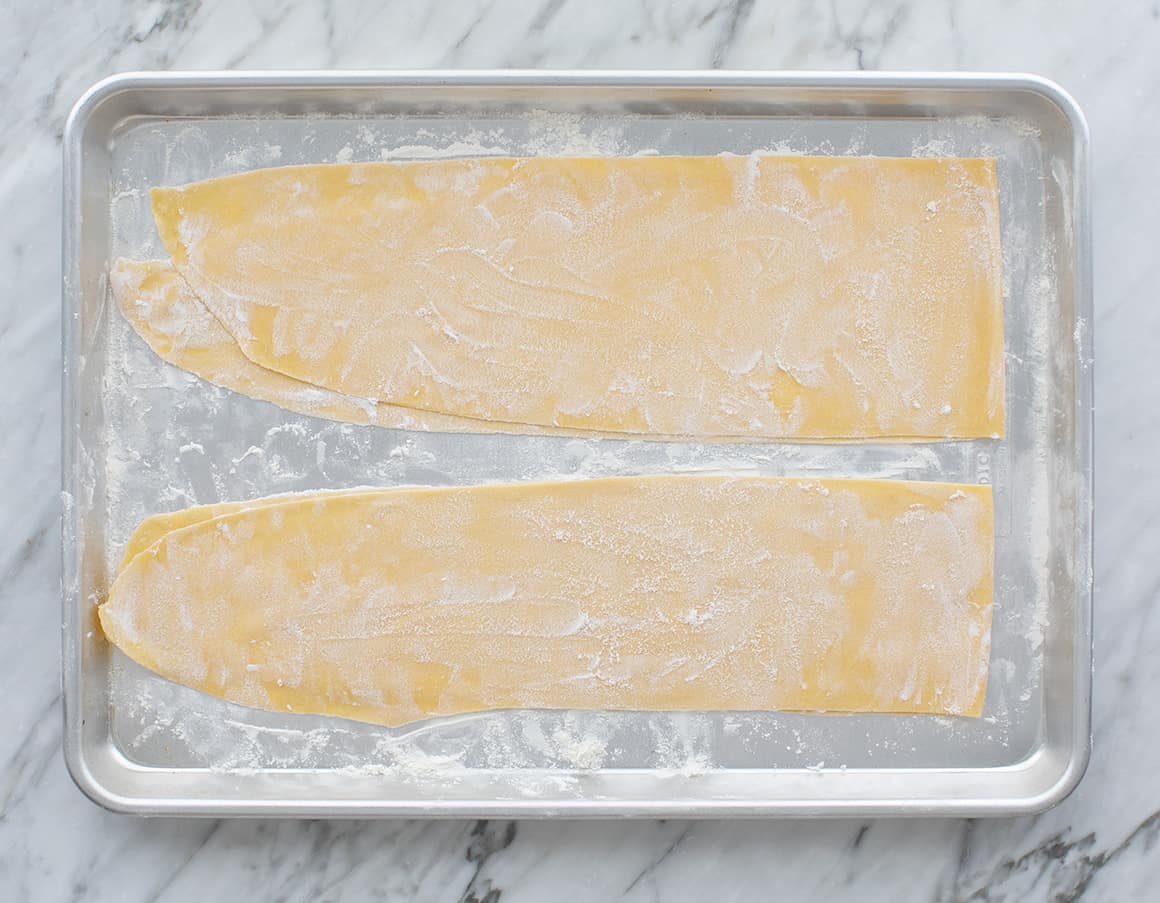
Finally, cut and cook the pasta. Run the pasta sheets through your desired pasta cutter attachment. Cook the noodles in a pot of boiling salted water for 1 minute, and enjoy!
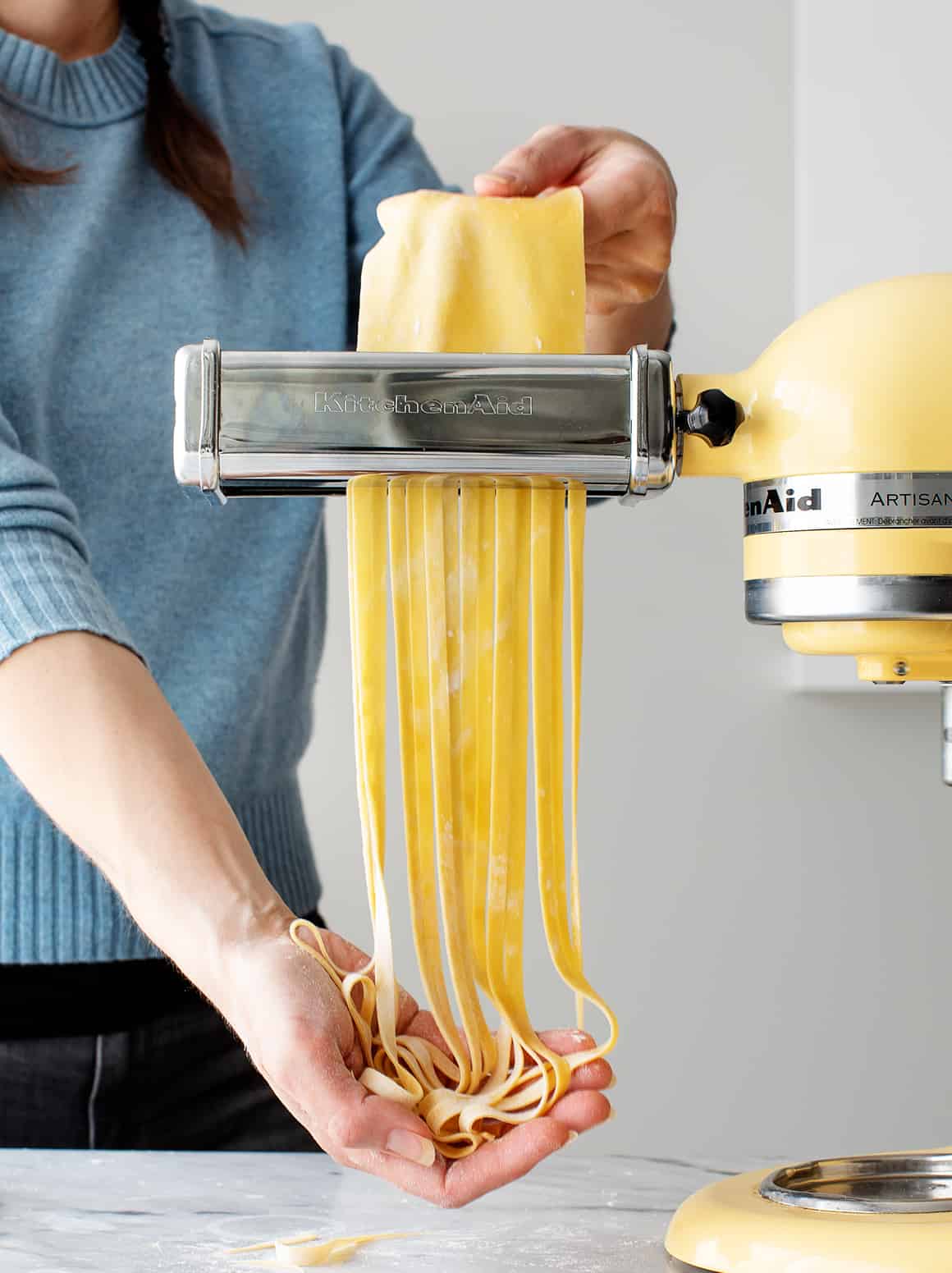
Homemade Pasta Serving Suggestions
If you’ve never had fresh pasta before, you’re in for a treat! Its chewy, bouncy texture and rich flavor make it so much better than the dried pasta at the store. In fact, these noodles are so good that we usually serve them really simply. They’re fantastic with marinara sauce, pesto, homemade Alfredo sauce, or olive oil and vegan Parmesan or Parmesan cheese.
Of course, they’re delicious in larger pasta dishes, too. Use them instead of dried pasta in any of these recipes:
- Tagliatelle with Asparagus & Peas
- Spaghetti Aglio e Olio
- Fettuccine Alfredo
- Easy Pesto Pasta
- Roasted Vegetable Pasta
- Linguine with Lemon and Tomatoes
- Garlic Herb Mushroom Pasta
Find more of my favorite pasta recipes here!


Homemade Pasta
Equipment
- KitchenAid Mixer (the stand mixer to use the pasta attachment)
- Pasta Attachment (my favorite KitchenAid attachment!)
- Baking Sheets (I use these nonstick ones from Nordic Ware)
Ingredients
- 2 cups all-purpose flour, spooned & leveled
- 3 large eggs
- ½ teaspoon sea salt
- ½ tablespoon extra-virgin olive oil
Instructions
- Place the flour on a clean work surface and make a nest. Add the eggs, olive oil, and salt to the center and use a fork to gently break up the eggs, keeping the flour walls intact as best as you can. Use your hands to gently bring the flour inward to incorporate. Continue working the dough with your hands to bring it together into a shaggy ball.
- Knead the dough for 8 to 10 minutes. At the beginning, the dough should feel pretty dry, but stick with it! It might not feel like it’s going to come together, but after 8-10 minutes of kneading, it should become cohesive and smooth. If the dough still seems too dry, sprinkle your fingers with a tiny bit of water to incorporate. If it’s too sticky, dust more flour onto your work surface. Shape the dough into a ball, wrap in plastic wrap, and let rest at room temperature for 30 minutes.
- Dust 2 large baking sheets with flour and set aside.
- Slice the dough into four pieces. Gently flatten one into an oval disk. Run the dough through the Pasta Roller Attachment or a pasta maker three times on level 1 (the widest setting).
- Set the dough piece onto a countertop or work surface. Fold both short ends in to meet in the center, then fold the dough in half to form a rectangle (see photo above).
- Run the dough through the pasta roller three times on level 2, three times on level 3, and one time each on levels 4, 5, and 6.
- Lay half of the pasta sheet onto the floured baking sheet and sprinkle with flour before folding the other half on top. Sprinkle more flour on top of the second half. Every side should be floured so that your final pasta noodles won't stick together.
- Repeat with remaining dough.
- Run the pasta sheets through the Pasta Cutter Attachment (pictured is the fettuccine cutter). Repeat with remaining dough. Cook the pasta in a pot of salted boiling water for 1 to 2 minutes.
Notes
adapted from Serious Eats








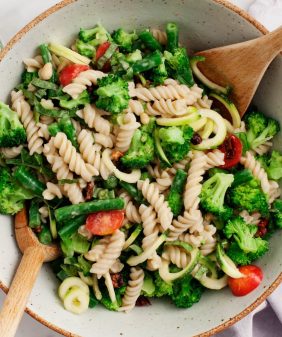





I have made this recipe several times and it’s amazing! It’s so easy and there’s nothing like fresh pasta!
Hi Bridget, I’m so glad you love the recipe!
Cool
This was my first time making pasta. I bought an attachment that fit my mixer, but was not the KA brand. “Antree” I followed your instructions to the letter. Came out perfectly!
And so fun!
Hi Ann, I’m so glad it came out perfectly!
Hi! Can I make this dough the night before if I’ll be rolling it out around 3pm the next day?
What are the nutritional facts on this pasta?
I’m sorry, we don’t post nutrition facts, but you could plug the ingredients into an online nutrition calculator.
Came out great! I tinkered with the recipe a bit and still worked perfectly. I just used a rolling pin and a pizza cutter to shape it but still worked amazingly. Made the pasta on a whim and it also lined up perfectly with my family’s dinner plans! Will definitely use this recipe again 🙂
Hi Rayne, thanks for your comment! I’m so glad you loved the pasta and that rolling it out and cutting it by hand worked so well.
Wondering if gluten free flour would yield the same quality
No, it will not.
Can you freeze this pasta?
I do love your recipes , but here your link to measuring flour states that weighing is the best way to measure ingredients (and that one should invest in kitchen scales). Makes perfect sense. Yet, your recipe states cups of flour, spooned and levelled !!? Maybe you could add the amount in grams ? Thanks ?
Hi Andrea, for this recipe, we just ask that you spoon and level to measure the flour. The weight should be between 120 and 125 grams per cup.
First time making noodles. They came out delicious and perfect. I will be making them often. Tip: use lots of flour when dusting to fold or pile them
Hi Emily, great tip! So glad you enjoyed the pasta.
Perfect. Work the dough for the prescribed length of time.
Did I miss something?
I was looking for a basic home-made pasta recipe, not an advertisement for a high-end kitchen appliance that I can’t afford.
Disappointing.
You don’t have to use the KitchenAid. You can use elbow grease and a rolling pin to get the floured dough thin. Then you can roll the dough onto itself and slice thinly into “pinwheels”. Then shake those out into lengths of pasta with your desired thickness.
Thanks Mo. I’ll give it a try ?♀️
You can also get a manual pasta machine for around $60-$70. I have an Imperia and an Atlas 150. They are both made in Italy and work great. They come with attachments for fettucine and tagliarini (spaghetti) and you can buy additional attachments if you desire.
I bought a hand crank for $40 before I decided to invest in KitchenAid attachments. Btw, which I haven’t purchased yet. I wanted to see if I would use first. I love making it. So far ice made fettuccine and ravioli. But I am very satisfied with hand crank, it is just as easy.
This recipe is quite good. You can use basic manual pasta machine or yep use rolling pin does the job too!
Yes, I agree with the commenters here! You can use a manual pasta maker (some run as low as $30) or roll out the pasta dough with a rolling pin and cut it with a sharp knife. Hope this helps, Lisa!
What?
I made pasta for the first time today with this recipe and it was so rewarding. I made it with my newly bough pasta roller from Lidl. I am so pleased! Thanks for the recipe and instructions!
Hi Carol, I’m so glad you loved it!
Just got a pasta maker but was wondering if you have ever tried making the dough in a bread maker
Yes
You can make the dough in a bread maker? That’s awesome! I never thought of that and my hands are so riddled with arthritis that I’ve almost given up on the idea of ever having fresh pasta again. It is so good, I’m going to give it a try. Thanks for the idea of using my barely used bread machine for pasta dough!
Love the recipe, but what am I doing wrong? 1-2 minutes is no where near enough cook time for me… any advice?
Hi. Thank you for sharing your recipe.
Wondering if you can advise the ingredient weight in metric. What is the equivalent in grams for 2 cups.
Regards
Sue
Hi Sue, 2 cups flour is about 250 grams.
Is this specific recipe in one of your cookbooks? I use it all the time and I’d love to have it in book form so I don’t have to find it every time on the internet.
Hi Jen, it’s not in the books. For the most part, the blog and book recipes are completely separate.
When refrigerating, do you let it get to room temp before rolling?
Hi Stacey, it doesn’t need to be fully at room temp, but I’d let it warm up for 15-30 minutes before rolling.
Found this and made it today. The noodles came out fabulously! The process was so well described, it was really easy! I had no idea. Thank you!
I’m wondering though, could I refrigerate or freeze half the dough in little rounds to use at a different time? I’ll have to try next time I make some to see how it turns out.
Hi Suzanne, if the dough is well-wrapped, you could refrigerate it for up to a day. I prefer to freeze homemade pasta after it’s rolled out and cut. You can boil it straight from frozen!
Hi, if cooking straight from frozen, how long do you boil it for?
I found that if I par boiled my dough inlasagna pieces.. cooled and then cut my tiny noodles..it comes out amazing… No sticking perfect noodles
Have you made this using almond or coconut flour? If so, how did it turn out?
Hi Michelle, those flours aren’t a 1:1 exchange for regular flour – I’d search for a site that specifically has a recipe that calls for either of those alternative flours.
What is the timeframe if I cook the pasta but don’t eat it all. Can it be leftovers?
I make it and it stays for several days. I also make it for meal prep.